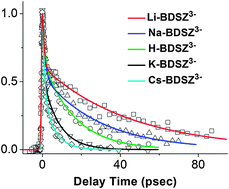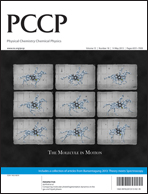Photoelectron spectra of isolated [M–BDSZ]3− (BDSZ = bisdisulizole, M = H, Li, Na, K, Cs) triply charged anions exhibit a dominant constant electron kinetic energy (KE) detachment feature, independent of detachment wavelengths over a wide UV range. Photoelectron imaging spectroscopy shows that this constant KE feature displays an angular distribution consistent with delayed rather than direct electron emission. Time-resolved pump–probe (388 nm/775 nm) two-colour photoelectron spectroscopy reveals that the constant KE feature results from two simultaneously populated excited states, which decay at different rates. The faster of the two rates is essentially the same for all the [M–BDSZ]3− species, regardless of M. The slower process is associated with lifetimes ranging from several picoseconds to tens of picoseconds. The lighter the alkali cation is, the longer the lifetime of this state. Quantum chemical calculations indicate that the two decaying states are in fact the two lowest singlet excited states of the trianions. Each of the two corresponding photoexcitations is associated with significant charge transfer. However, electron density is transferred from different ends of the roughly chain-like molecule to its aromatic center. The energy (and therefore the decay rate) of the longer-lived excited state is found to be influenced by polarization effects due to the proximal alkali cation complexed to that end of the molecule. Systematic M-dependent geometry changes, mainly due to the size of the alkali cation, lead to M-dependent shifts in transition energies. At the constant pump wavelength this leads to different amounts of vibrational energy in the respective excited state, contributing to the variations in decay rates. The current experiments and calculations confirm excited state electron tunneling detachment (ESETD) to be the mechanism responsible for the observed constant KE feature. The ESETD phenomenon may be quite common for isolated multiply charged anions, which are strong fluorophores in the condensed phase – making ESETD useful for studies of the transient response of such species after electronic excitation.

You have access to this article
 Please wait while we load your content...
Something went wrong. Try again?
Please wait while we load your content...
Something went wrong. Try again?


 Please wait while we load your content...
Please wait while we load your content...